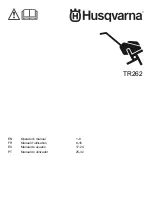
92
AGR 070A through 100A
IOMM AGR-1
3.
Remove power from the controller by opening CB1. Try to improve the connections in the
Aux/Out plug insulation displacement terminals by pressing down on the wires with a small
screwdriver.
4.
Check all other wiring and connectors for bent pins or mis-wires.
If the chatter does not stop, the electromechanical relay or contactor is probably defective.
Troubleshooting Solid-State Relays
As shown on the unit wiring diagrams, the Solid-State relays on the Output Boards all have normally
open “contacts.” Actually, these contacts do not exist as they do in an electromechanical relay.
Instead of using contacts to switch the load, the Solid-State relay changes its resistance from low
(closed), when it is energized, to high (open), when it is de-energized. (This high resistance is
approximately 100K ohms.) Because the output circuit through the Solid-State relay remains
continuous regardless of whether the relay is energized, troubleshooting a Solid-State relay with a
voltmeter can be tricky.
In a typical circuit, a power source is connected across a single relay output and a load. In this circuit,
a Solid-State relay will behave like an electromechanical relay. If the relay is energized, the relay
output will be hot. If the relay is de-energized, voltage cannot be measured at the relay output.
The circuit shown in Figure 40 is similar to a typical circuit; the difference is that there is an open set
of contacts, or a disconnection between the relay output and the load. In this circuit, a Solid-State
relay will not behave like an electromechanical relay. If the Solid-State relay is energized, the relay
output will be hot (as expected). However, if the Solid-State relay is de-energized, the relay output
will still appear to be hot. This is because the relay output and the voltmeter form a continuous
circuit in which the relay’s resistance, though high, is insignificant compared to the voltmeter’s
resistance.
This means that nearly all the voltage is dropped across the voltmeter. Therefore, the voltmeter
indicates that voltage is present. If a low wattage light bulb of the appropriate voltage is used instead
of a voltmeter, the bulb’s low resistance will load the circuit enough to eliminate the false voltage
indication. In this situation, an incandescent test lamp is a better tool than a voltmeter.
Figure 40, Testing a Typical Relay Circuit
Figure 41, Testing a Relay Circuit with a Disconnection
M10
0V
115 VAC
Output Board
DO 13
28
27
Neutral
M10
115V
115 VAC
Output Board
DO 13
28
27
Neutral
Summary of Contents for AGR 070AS
Page 20: ...20 AGR 070A through 100A IOMM AGR 1 Figure 9 Typical Field Wiring with Global UNT Controller...
Page 22: ...22 AGR 070A through 100A IOMM AGR 1 Figure 11 Standard Single Point Connection with FanTrol...
Page 24: ...24 AGR 070A through 100A IOMM AGR 1 Figure 13 Unit Control Schematic 2 compressor UNT...
Page 25: ...IOMM AGR 1 AGR 070A through 100A 25 Figure 14 Staging Schematic 2 compressor 4 stage UNT...
Page 26: ...26 AGR 070A through 100A IOMM AGR 1 Figure 15 Staging Schematic 2 compressor 6 stage UNT...
Page 27: ...IOMM AGR 1 AGR 070A through 100A 27 Figure 16 MicroTech Controller Schematic...
Page 28: ...28 AGR 070A through 100A IOMM AGR 1 Figure 17 Unit Control Schematic MicroTech...
Page 29: ...IOMM AGR 1 AGR 070A through 100A 29 Figure 18 Staging Schematic 4 stage MicroTech...
Page 30: ...30 AGR 070A through 100A IOMM AGR 1 Figure 19 Staging Schematic 6 stage MicroTech...
Page 31: ...IOMM AGR 1 AGR 070A through 100A 31 Figure 20 Unit Control Schematic 2 compressor MicroTech...
Page 32: ...32 AGR 070A through 100A IOMM AGR 1 Figure 21 UNT Instrument Layout See legend on page 34...
Page 35: ...IOMM AGR 1 AGR 070A through 100A 35 Figure 25 MicroTech Sensor Layout...
Page 99: ...IOMM AGR 1 AGR 070A through 100A 99 Notes...
Page 100: ...Post Office Box 2510 Staunton Virginia 24402 USA 800 432 1342 www mcquay com...









































